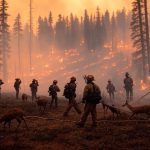
Wildfires Rage Worldwide in 2025: A Global Crisis Unfolds
March 25, 2025Wildfires are tearing through landscapes worldwide in 2025, from South Korea’s dense forests to Texas’s arid plains and North Carolina’s rugged mountains. Fueled by climate change, drought, and human activity, these fires are devastating communities, ecosystems, and cultural landmarks. As of late March, the year’s first quarter has seen an alarming surge in fire activity, stretching emergency responses thin across continents. Here’s a look at the wildfire crisis gripping the globe.
South Korea: A Cultural Tragedy
South Korea is reeling from wildfires that erupted over the March 22-23 weekend, claiming four lives, including three firefighters. Driven by dry conditions and fierce winds, the fires have consumed roughly 16,000 acres of forestland. Over 9,000 personnel and 105 helicopters are battling the blaze—one of the nation’s worst in decades—which destroyed the ancient Silla Dynasty temple, a cultural treasure. Evacuations persist as firefighters contend with treacherous terrain and shifting winds.
United States: A Multi-State Inferno
In the U.S., wildfires are raging across multiple regions. Texas faces severe fire risk in the Southern Great Plains, where drought and gusty winds have ignited numerous blazes in recent weeks. The National Interagency Fire Center warns of high-danger conditions into April, with 122% of the 10-year average acreage burned nationwide this year. California, still scarred from January’s Palisades and Eaton fires—which razed over 16,000 structures and killed 29 people—has seen 545 wildfires scorch 58,085 acres in 2025 so far, though no large fires are currently active.
North Carolina is grappling with the Black Cove Complex fires in Polk County, burning over 4,621 acres as of March 23 evening. The North Carolina Forest Service reports zero containment on two large fires spanning 1,100-1,240 acres each, prompting mandatory evacuations and a “Code Red” air quality alert. A statewide ban on open burning reflects critical fire weather, worsened by Hurricane Helene’s 2024 debris. Smaller, uncontained fires dot the state, straining resources further.
Chile: Mass Evacuations Underway
In Chile, a massive wildfire reported on March 23 has forced widespread evacuations. High temperatures and a prolonged dry spell have accelerated the fire’s spread, though exact acreage and casualty figures are pending. The response echoes global efforts to safeguard lives and infrastructure, recalling Chile’s destructive fire seasons in 2017 and 2023. Emergency teams are racing against the clock as the blaze nears populated zones.
A Worldwide Blaze
The fire surge spans continents. Bolivia and Brazil’s Amazon saw record emissions in 2024, a trend likely persisting into 2025. Canada’s boreal forests, which released 2 billion tonnes of CO2 in 2023, face another perilous season, while Portugal and Eastern Europe brace for elevated risks. Online posts highlight fires in South Korea, Chile, and the U.S., with some claiming hundreds of blazes stateside, reflecting widespread alarm.
Climate change amplifies the crisis, extending fire seasons and drying vegetation. California’s dry season has grown by 23 days since pre-industrial times, a shift mirrored globally. Strong winds—like those in South Korea or California’s Santa Ana gusts—fan the flames, while urban sprawl into wildlands increases vulnerability, creating a perfect storm for catastrophic burns.
Devastation and Consequences
The toll is immense. Forests, vital carbon sinks, are vanishing, releasing stored CO2 and worsening climate change. Canada’s 2023 fires accounted for nearly a quarter of global wildfire emissions, a pattern echoing in the Amazon. Air quality has crashed—Los Angeles hit “very unhealthy” levels in January, and North Carolina’s smoke now blankets nearby counties. Health risks, from respiratory issues to long-term conditions, are mounting, alongside losses of lives, homes, and heritage.
South Korea mourns its fallen firefighters, Chile its displaced residents, and the U.S. its growing death toll—29 in California, four in North Carolina’s earlier March fires. Economic and ecological recovery will take years, compounded by concurrent disasters like volcanic eruptions and earthquakes.
The Road Ahead
Forecasts offer little reprieve. The U.S. anticipates above-normal fire potential through June across Texas, New Mexico, Arizona, and the Southeast, including North Carolina. South America’s Pantanal and Canada’s west are also at risk. The upcoming State of Wildfires report may confirm 2025 as a record year if trends hold. Experts call for controlled burns, forest restoration, and climate action, but the scale demands global coordination.
Insurance Pullouts and Conspiracy Theories
A troubling subplot has emerged: insurance companies withdrawing fire coverage in fire-prone regions just before the 2025 outbreaks. In California, firms like State Farm and Allstate halted new policies in 2023, citing rising risks, a trend now evident in Texas, North Carolina, and even parts of Chile. Residents report cancellations or skyrocketing premiums in the months leading up to this year’s fires, leaving many uninsured as flames approached. In North Carolina’s Polk County, some homeowners affected by the Black Cove Complex fires learned their policies were dropped in late 2024, citing “unmanageable wildfire exposure.”
This timing has fueled speculation, particularly given discussions about transforming these areas into “smart cities.” California’s fire-ravaged zones, like parts of Los Angeles, have been eyed for tech-driven redevelopment since 2022. North Carolina’s western counties, including Polk, featured in 2024 state planning sessions for sustainable urban hubs. Texas and Chile have seen similar proposals, with local leaders touting resilience through innovation. Online theories suggest insurers and developers might be colluding to clear land for these projects, pointing to the sudden coverage cuts as evidence of foreknowledge.
As the world burns, the interplay of nature, policy, and suspicion adds a complex layer to an already dire crisis, testing resilience on every front.








